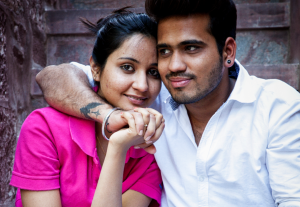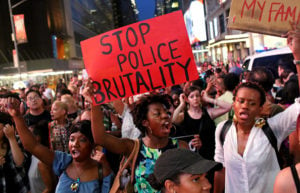Originally published on The Establishment and republished here with permission.
The last few years have been particularly trying for communities of color.
Between police brutality, deportations, rising Islamophobia, and Donald Trump, America is becoming increasingly inhospitable for its non-white inhabitants.
Against this backdrop, Martin Luther King Jr.’s words about “the fierce urgency of now” to unite and take action against injustice are just as relevant now as they were when he first said them in 1963.
That’s according to activist and author Deepa Iyer, whose book, We Too Sing America: South Asian, Arab, Muslim, and Sikh Immigrants Shape Our Multiracial Future, is centered on the fact that although communities of color often see their struggles as unique in this country, there are actually many shared experiences of facing white-led oppression.
And so, we must find ways to be in solidarity with each other to combat racism and xenophobia.
Iyer’s book focuses on how in the aftermath of 9/11, our so-called “model minorities” – South Asians, Arabs, Muslims, and Sikhs – have faced persistent state-sanctioned racism, xenophobia, and violence.
Historically lauded for being well-educated and law-abiding minorities, over the past fifteen years, these communities have become increasingly vilified and persecuted.
And Iyer contends that in order to liberate oppressed communities, whether talking about anti-black racism or Islamophobia, communities of color must come together in multiracial organization.
As a fairly new immigrant myself, I’m particularly fascinated by Iyer’s thesis. It will be almost four years to the month when I moved from Singapore to the United States.
The visa category on which I was granted access to this country became the defining way my immigrant and minority experience has played out in America.
The government decided that my family had to be highly-educated, well-earning, and (ideally) working in science or technology to be granted the golden prize of living in this country.
I can never claim to have experienced the systemic oppression that Black or undocumented communities have faced here, and I was fearful of raising my voice for immigrant issues, never expressing solidarity with movements like Black Lives Matter or Dreamers.
I understand now that by not speaking up against injustices, immigrants like me are often complicit in the systemic oppression of other communities of color.
As Iyer notes, “9/11 should have been a wakeup call that the South Asian community is not immune from oppression in this country,” But it wasn’t.
South Asians, myself included, continued to do their damnedest to live up to the model minority myth, all while detentions and deportations of innocent members of our community continued in the name of “national security.”
Iyer brings up the case of Sureshbai Patel, the 57-year-old Indian grandfather who was brutally attacked by police and left partially paralyzed while walking innocently in his son’s neighborhood.
A white neighbor who was suspicious of the man called the police, who took Patel’s limited English-speaking capabilities as a reason to beat him down. Unsurprisingly, earlier this week, the officer who caused Patel the grave injury was acquitted on charges of using excessive force.
As we contemplate the injustices faced by the Black community in this country, it’s humbling to realize the Black Lives Matter Movement is germane to all non-white communities.
The message in this country is increasingly becoming: If you’re not white, you’re always considered a threat.
And until we all come together to challenge the status quo, injustices like these will continue.
It is with this premise that I began my interview with Iyer.
What Has Led to This Alarming Level of Racism and Brutality Toward Communities of Color in America?
Iyer: In my book, I talk about the role of the state, government, and state in setting up structural inequities against communities of color and that pit communities of color against each other.
The state plays a significant role in fueling an environment where discrimination can occur, and that’s what’s happened since 9/11.
We’ve had these horrible national security and immigration policies that have set up this perception that people who are South Asian, Muslim, or Arab are suspects and disloyal..which leads to violence against those communities.
The next step for us is to figure what it means [for communities of color] to stand in solidarity with each other, especially as the demographics of this country are shifting so rapidly.
How Can South Asians Stand in Solidarity with Other Communities of Color?
Iyer: When we talk about solidarity, we have to talk about how much, specifically, anti-Black racism has become part of the narrative in this country. It’s embedded in policies and in the way the immigrant communities treat Black communities in particular.
There’s a quote from Toni Morrison that I allude to in my book that says becoming totally Americanized for an immigrant means participating in the animosity against Black people.
Many South Asians, even from their time in South Asia, have perpetuated that sort of racism against the Black community – having negative assumptions and perceptions about black people…and seeing Black people as the lowest race on a totem pole or a racial ladder.
We have to confront anti-Black racism within our community to disrupt the racial hierarchy that we have in this country.
What Needs to Change Within the South Asian Community in America?
Iyer: We need to do the hard work within our communities. It means not giving in to the immigrant and cultural exceptionalism narrative that we’re all “spelling bee” winners and all Silicon Valley tech entrepreneurs and that we’re all successful.
That’s negative because it doesn’t tell the truth about our own community. But also, it pits us against other communities.
We need to be more in solidarity with certain movements like Black Lives Matter. There’s been more South Asian presence in rallies and solidarity with civil disobedience movements.
Also, we need to talk about how the oppression of the Black Lives Matter movement is connected, although different, to some of the oppression South Asian communities face.
In particular, you can look at the role of the state in police brutality, immigrant detentions and deportations, and surveillance of the Muslim communities. So the linkages are there for us to find, so we can connect our own histories and our oppressions to that movement as well. And see that we’re in it together.
How Have Many South Asians Had Such a Unique Experience in This Country?
Iyer: Many South Asians come in [to America] with a fair amount of privilege, especially with the immigration paths. So, when people are here and they don’t recognize the privilege that they come in with, they’re more apt to buy into the “exceptionalism” narrative instead of seeing the threads that link us.
It’s important that we don’t say that all South Asians are the same.
Within the community there are vast disparities, including access to education, housing, job creation, wealth…all of those are issues we face as well.
In fact, Indians make up the fourth largest undocumented population in America as of 2015. So, there are people in our own communities who need that sort of attention, so exceptionalizing the community as a whole isn’t helpful.
What Can South Asians and Other Communities of Color Learn from Black Lives Matter?
Iyer: Activists in the movement have articulated the urgency of the moment, and its historic patterns and modern narratives that continue to oppress black people. So we need to understand the language and understand where it’s coming from.
Secondly, we should see ourselves as communities of color in this country, so we can find that common cause. And then follow the ways the movement is engaging in powerful strategies such as political accountability and civil obedience, for us to learn from.
Non-black communities, as I quote Dante Berry in my book, must engage as co-conspirators for change.
*Note: After my interview with Iyer, I looked up Dr. King’s March on Washington quote in its entirety. It could have been written today, not 53 years ago: “In this unfolding conundrum of life and history, there ‘is’ such a thing as being too late. This is no time for apathy or complacency. This is a time for vigorous and positive action.”
Check out more from The Establishment:
[do_widget id=’text-101′]
Ruchika Tulshyan is The Establishment’s Contributing Editor. She recently published her first book, The Diversity Advantage, for Forbes. Her work has also appeared in the Wall Street Journal, TIME, and Bloomberg.
Search our 3000+ articles!
Read our articles about:
Our online racial justice training
Used by hundreds of universities, non-profits, and businesses.
Click to learn more





















